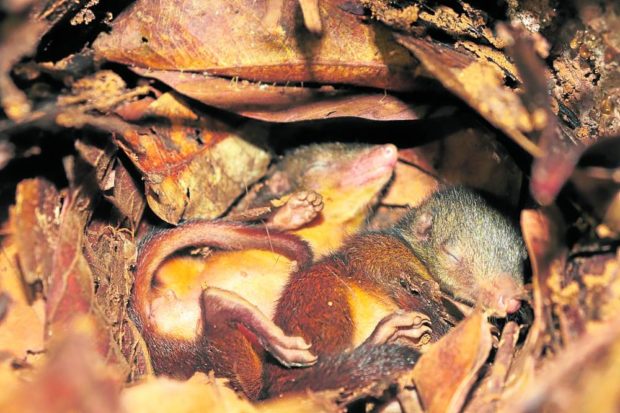After 70 years, Mindanao treeshrew nest rediscovered on Dinagat Islands

NEWBORN | A pair of newborn Mindanao treeshrews (Tupaia everetti) is discovered by two Filipino biologists in July 2022 in a nest within the Mounts Kambinliw-Redondo key biodiversity area on Dinagat Islands. (Photo courtesy of TRISTAN LUAP SENARILLOS)
KORONADAL CITY, South Cotabato, Philippines — For the first time after at least 70 years, two Filipino biologists were able to document the behavior of a pair of newborn Mindanao treeshrews (Tupaia everetti) — a mammal resembling a chipmunk — on Dinagat Islands.
Tristan Luap Senarillos and Jayson Ibañez, both conservationists of the Philippine Eagle Foundation, said they discovered the nest site of the treeshrews within the Mounts Kambinliw-Redondo key biodiversity area in Dinagat while they were carrying out a rapid faunal assessment in the aftermath of Typhoon “Odette” (international name: Rai) that devastated the island in December 2021.
“This nest discovery is a valuable contribution to the minimal existing literature about this poorly studied species, which may be increasingly threatened by anthropogenic impacts,” the two biologists wrote in the study, “Notes on the Nest Architecture and Nest Site Characteristics of Mindanao Treeshrew (Tupaia everetti Thomas, 1892) from Dinagat Islands, Philippines,” published on March 1 this year in the Philippine Journal of Science.
Anthropogenic impact refers to changes to biophysical environments and to ecosystems, biodiversity and natural resources caused directly or indirectly by humans.
In July 2022, the biologists found the Mindanao treeshrew nest built inside a cavity of a dead pandan tree on the ground surrounded by natural vegetation. But they did not see the attending parents during the encounter.
Article continues after this advertisementThey were in Barangay General Aguinaldo in Libjo town to document birds, amphibians and reptiles, and nonvolant (incapable of flying) mammals after the ravages of Odette when they accidentally found the nest of the treeshrews.
Article continues after this advertisement“[They are] secretive. They have adapted to or specialized in climbing,” Senarillos told the Inquirer on Sunday.
“So far, what we know [about treeshrews] is that they are diurnal (daytime) animals, are omnivores (plant and animal eaters) and found in areas associated with forests,” he said, adding: “They’re so difficult to find in the field, unless they’re trapped for study purposes.”
The Mindanao treeshrew is one of only two endemic treeshrews in the Philippines after that of the Palawan treeshrew (Tupaia palawanensis).
‘Species of least concern’
According to the study, the Mindanao treeshrew is an enigmatic nonflying mammal found only in the mountainous areas of mainland Mindanao and in smaller nearby islands, including Dinagat and Siargao. It is classified as a species of “least concern” by the International Union for Conservation of Nature Red List of Threatened Species.
It lives in dense vegetation near streams in lowland evergreen forests (below 500 meters above sea level or masl), up in the mossy forests (2,250 masl) and is sometimes found in varying densities in disturbed forest habitats, according to the study.
In the wild, the Mindanao treeshrews use ground hollows as nests and hiding places, as noted in the 1950 study, “Notes on the Philippine Treeshrew,” published by Charles Wharton in the Journal of Mammalogy.
With regard to breeding, females in captivity are reported to produce two offspring after a gestation period of 54 to 56 days, the study by Ibañez and Senarillos noted.
Senarillos said there was little information about treeshrew species in the Philippines but based on studies with their relatives in peninsular Borneo, the Tupaia species are believed to be seed dispersers, helping to regenerate fruiting trees in the forests they inhabit.
The juvenile Mindanao treeshrews found in the nest were both males. “They slept in a curled, tight ball position, with the top of the head located very close to the belly, or in a ventral position with the tail resting on top of the belly,” the study said. “Whenever the nest was disturbed, the juveniles became active and made an explosive snort and quick scratching motions, probably a form of territorial defense to deter predators and other nest intruders,” the study noted.